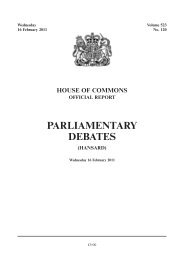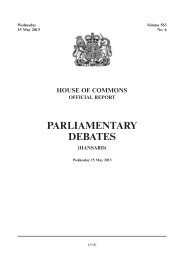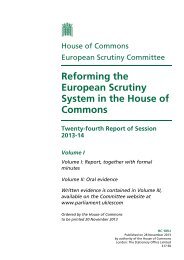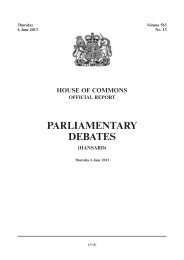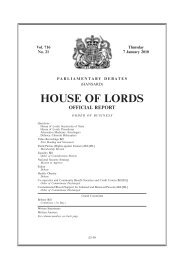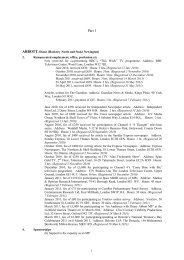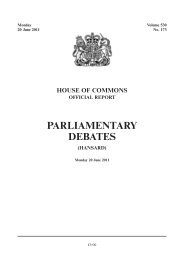Ticketing and Concessionary Travel on Public Transport - United ...
Ticketing and Concessionary Travel on Public Transport - United ...
Ticketing and Concessionary Travel on Public Transport - United ...
You also want an ePaper? Increase the reach of your titles
YUMPU automatically turns print PDFs into web optimized ePapers that Google loves.
Ev 134 <strong>Transport</strong> Committee: Evidence<br />
C. Specific Questi<strong>on</strong>s Raised by the Committee<br />
Integrated ticketing<br />
1. Is ticketing suYciently integrated across diVerent modes of transport <str<strong>on</strong>g>and</str<strong>on</strong>g> between diVerent geographical<br />
areas?<br />
A high level of integrati<strong>on</strong> has been established by train operators, as set out above. Integrati<strong>on</strong> is<br />
particularly needed in urban areas, <str<strong>on</strong>g>and</str<strong>on</strong>g> requires proper c<strong>on</strong>tractual relati<strong>on</strong>ships <str<strong>on</strong>g>and</str<strong>on</strong>g> a sound legal basis,<br />
c<strong>on</strong>solidating the block exempti<strong>on</strong> by the OYce of Fair Trading which underpins bus/rail ticketing.<br />
C<strong>on</strong>tinuing referrals of train operators to the Competiti<strong>on</strong> Commissi<strong>on</strong> where short-listed bidders also<br />
operate buses in the area do not help to build c<strong>on</strong>fidence.<br />
2. Does the Government have an adequate strategy for developing the integrati<strong>on</strong> of ticketing systems?<br />
Government has been the driving force behind <strong>Transport</strong> Direct, the key to providing informati<strong>on</strong> about<br />
integrated journeys, <str<strong>on</strong>g>and</str<strong>on</strong>g> has supported ITSO, but the strategy <strong>on</strong> integrated ticketing has so far been led by<br />
train operators through ATOC, <str<strong>on</strong>g>and</str<strong>on</strong>g> in the case of Plusbus, in partnership with bus operators through<br />
Journey Soluti<strong>on</strong>s.<br />
The railway has been criticized over the complexity of its fares structure <str<strong>on</strong>g>and</str<strong>on</strong>g> is working hard to simplify<br />
it. From the beginning of March, the Nati<strong>on</strong>al Rail Enquiry Service web journey planner has simplified<br />
displays to give passengers much better informati<strong>on</strong> <strong>on</strong> the cheapest tickets available for the journey they<br />
want to make. However, integrated ticketing adds to that complexity, <str<strong>on</strong>g>and</str<strong>on</strong>g> this is being addressed through<br />
simple add-<strong>on</strong> fares such as Plusbus <str<strong>on</strong>g>and</str<strong>on</strong>g> the use of smartcard technology.<br />
The use of smartcard technologies<br />
3. Is the industry taking up modern smartcard technologies adequately <str<strong>on</strong>g>and</str<strong>on</strong>g> appropriately?<br />
Yes. Commercial pressures are driving a rapid take-up of new ticketing technologies. Train operators<br />
have devoted substantial resources to accepting Oyster travelcards in L<strong>on</strong>d<strong>on</strong> (<str<strong>on</strong>g>and</str<strong>on</strong>g> are now moving to<br />
accept Pay as you Go as well). TOCs have been in the forefr<strong>on</strong>t of the development of e-ticketing <str<strong>on</strong>g>and</str<strong>on</strong>g><br />
permissi<strong>on</strong> to travel by mobile ph<strong>on</strong>e. ATOC has been part of ITSO from the outset.<br />
4. Does the ITSO system cater for the needs of all passengers <str<strong>on</strong>g>and</str<strong>on</strong>g> travel providers?<br />
Yes, ITSO is comprehensive, but in practice is likely to be more widely used for frequently made local<br />
journeys than for l<strong>on</strong>g distance travel or infrequent trips.<br />
5. What can be learned from the experiences of areas such as L<strong>on</strong>d<strong>on</strong> <str<strong>on</strong>g>and</str<strong>on</strong>g> Scotl<str<strong>on</strong>g>and</str<strong>on</strong>g> where smartcard technology<br />
is already in place?<br />
The less<strong>on</strong>s learned from L<strong>on</strong>d<strong>on</strong> are that of the need for a nati<strong>on</strong>al st<str<strong>on</strong>g>and</str<strong>on</strong>g>ard, <str<strong>on</strong>g>and</str<strong>on</strong>g> that when specified it<br />
should be capable of use by all operators involved, rather than requiring the retrofitting a system designed<br />
for a diVerent purpose. The sec<strong>on</strong>d less<strong>on</strong> is that smartcards require simple fare structures.<br />
Revenue protecti<strong>on</strong> <str<strong>on</strong>g>and</str<strong>on</strong>g> the powers of ticket inspectors<br />
6. Is the legal framework within which ticket inspectors functi<strong>on</strong> appropriate?<br />
Yes. They work within the Penalty Fares Rules 2002, established by the Department for <strong>Transport</strong> under<br />
the Penalty Fares Regulati<strong>on</strong>s, 1994 <str<strong>on</strong>g>and</str<strong>on</strong>g> s.130 of the Railways Act, 1993. They are applied to:<br />
— Southeastern (inner suburban area <strong>on</strong>ly).<br />
— Southern (inner suburban area <strong>on</strong>ly).<br />
— South West Trains (inner suburban area <strong>on</strong>ly).<br />
— First Capital C<strong>on</strong>nect (Bedford to Redhill <strong>on</strong>ly).<br />
— One (most routes other than paytrain lines).<br />
— c2c Ltd (all routes).<br />
— First Great Western (West Drayt<strong>on</strong> to Paddingt<strong>on</strong> <str<strong>on</strong>g>and</str<strong>on</strong>g> branches <strong>on</strong>ly).<br />
— Central Trains (Birmingham area <strong>on</strong>ly).<br />
— Chiltern Railways (all routes).<br />
— Northern (Leeds area <strong>on</strong>ly).



